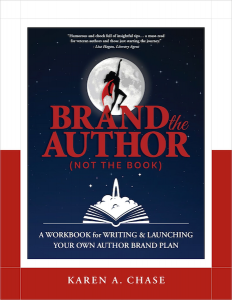
Today’s post is excerpted from Brand the Author (Not the Book) by Karen A. Chase (@KarenAChase).
Certain words and phrases are bandied about all the time in publishing, but they don’t always make sense. One of the biggest is author platform. You may have attended enough writing seminars and conferences to recognize that even people in publishing aren’t consistently using the term.
How and where authors reach readers: that’s platform. It’s a combination of four factors, and let’s use the TV show Gilmore Girls to help visualize it.
- Message: an announcement shouted to the citizens of Stars Hollow from the gazebo
- Target Audience: the Stars Hollow citizens gathered to hear it
- Platform Tools: the gazebo and the directional signs to it
- Brand Elements: the gazebo they see and experience
If your message and tools are built effectively, those in your target audience will be so invested in your platform, they will personally deliver that message to anyone drinking coffee with Lorelai and Rory at Luke’s Diner.
If you need to run off and watch a few episodes to understand my analogy, I’ll wait here. For those who have already seen the show, let’s start with the author message…
1. Author message (the announcement from the gazebo)
I know you have something to say. You wrote a book! But your author message is not the subject of that book. Rather, your author message is tied to why you wrote that book.
For instance, my first novel, Carrying Independence, is about a guy hired to help gather the final signatures on the Declaration of Independence. But why I wrote this story has nothing to do with the document. I firmly believe we can learn about ourselves by traveling and engaging in history.
Sure, other authors are also motivated by one or both of those things, but when I couple my belief with my particular brand of humor and unbridled nerdy enthusiasm, my author message becomes intrinsically mine. It becomes my purpose, and one my readers can experience with me. They can #TravelWithAdventure while #ChasingHistories, too.
For some authors, the reason they write is to provide an escape. For others, it may be to debunk faulty thinking. Once you define your message, you must figure out how to share your message.
2. Target audience (the citizens gathering around the gazebo)
These are the loyal readers most likely to gather around your gazebo (real or virtual). If you are a young adult (YA) author, yet your Twitter feed and primary contacts are moms and librarians, you’re not speaking directly to your readers. Or, as I said to a YA author with this problem, your target audience of teenagers is talking about books in the cafeteria while you’re hanging out in the teachers’ lounge sounding like a boring grown-up. Yes, librarians recommend books, but authors should connect with the bullseye of their target—the people most likely to jam their noses into your book and who will then turn to their friend and say, “You also have to jam your nose into this book.”
Your readers hang out in certain places online and physically. They have other books, magazines, movies, vocabulary, and activities they love (or hate). For example, if you write Georgian romances, your readers are likely women ages 16 to 65 who read Jane Austen, follow Colin Firth, know the difference between corsets and stays, and might be members of Regency societies.
3. Platform tools (the gazebo and directional signs to it)
If all you have is a gazebo from which to sell your book, your readers will consist of only those citizens who happen to come to the town square. That means you need to think bigger, broader. A platform tool is anything a reader will engage with that comes from you. If they can see it, touch it, or hear it, it’s a platform tool. If you’re a cookbook author or your novel includes recipes in the back, your loyal readers may even taste it!
Tools, like directional signage pointing to the gazebo, are the means by which your target audience finds and engages with you. What are your primary tools? Your book(s), website, and newsletter. You also have social media, advertising, publicity, presentations, and even printed materials such as bookmarks and business cards.
However, not all platform tools are effective at capturing your particular target audience. YA readers are less likely to be on Facebook than on Instagram, for example. And AARP events and retirement communities won’t be ideal places for middle-grade authors to give presentations. Examining your goals and existing assets will help you narrow down which tools are best for you and prioritize which ones to build first.
4. Author brand elements (the gazebo they see and experience)
Going back to our Gilmore Girls reference, when the citizens of Stars Hollow gather around to hear your message at that gazebo, what pray-tell does your gazebo look like? Does it look like a faded Victorian postcard, the colorful Barkcloth of Uganda, or a sleek Aston Martin à la James Bond? Brand elements consist of the author photo, the colors on your materials, the fonts that grace all your printed materials, and the way all those elements work together.
Brand elements are not designed using the cover of your books because each book design has its own set of brand elements. Book covers can vary wildly. You might not always have the same publisher or designer. You might write across genres as well. Three of your books could be repackaged and their covers redesigned.
Because book design does not affect your long-term author image, choose brand elements by considering your message, audience, and platform tools. You must also restrain yourself and keep these elements simple. Too many fonts or colors can lead to inconsistencies. Having fewer elements can contribute to greater longevity. All these brand elements, platform tools, and messaging come together to be your …
Author brand
An author brand is the experience readers have when they hear your message and interact with your particular platform tools. Think of the brands you are most loyal to. What do you see? How do you feel about them? If I say Coca-Cola, you can see the swirling font, the red color, the shape of the bottle. You might also get nostalgic about those warm and fuzzy holiday commercials with the polar bears. All of that adds up to how you feel about the brand. The same applies to authors.
Every effective brand has these three characteristics going for it: Unique. Consistent. Authentic.
Unique. REI branding is different from Patagonia even though they both sell outdoor gear. Look at branding for Sadeqa Johnson versus Danielle Steel. Readers feel something different for each of these authors even though they both write historical fiction. Authors, like brands, can’t copy one another.
Uniqueness breeds loyalty. Be who you are. Own who you are.
Consistent. If an author’s PowerPoint presentation looks like his or her website, which also looks like the author’s Twitter page, website and business card, then readers can be certain of who they’re following. Coca-Cola has had that same logo since 1886—it’s consistent, even if the company’s ad campaigns change every year.
Authentic. We live in a transparent world and audiences are getting better at pointing out B.S. when they see it. B.S. = Brand Stupidity. B.S. happens when a brand says one thing but the reality and/or actions are quite another.
That’s especially important when it comes to your author message. For example, I love nearly everything about traveling, and I believe travel is necessary to understanding history. However, if I secretly hated traveling and never left home, eventually my inauthenticity would catch up with me. Your words and actions have to match.
Note from Jane: If you enjoyed this post, be sure to check out Brand the Author (Not the Book) by Karen A. Chase (@KarenAChase).
Karen A. Chase is an author and photographer, and a Daughter of the American Revolution with the Commonwealth Chapter in Virginia. Her first novel, Carrying Independence, is historical fiction about the signing of the Declaration of Independence. Karen is a Virginia Foundation for the Humanities fellow for the 2019-2020 academic year. Originally from Canada, Karen is now chasing histories from Richmond, Virginia, and you can find a list of her events at her website.


Awesome article. I recommend it for authors who want their branding to be consistent. Love the Stars Hollow/Gilmore Girls connection.
Thanks for the comment, Anne. So often folks get all these terms confused and yet they’re so important. Hopefully Loreli and Rory would approve of the references. 🙂
Really helpful analogies and examples, Karen. This is the clearest, most comprehensible discussion of the differences between platform and brand I’ve read. On my way to buy to book.
Many thanks!
Thank you so much for the lovely comment and for going and seeking out the book. These terms were all over the place when I first started going to writing Conferences so I’m glad to finally sort them out for others.
Karen, I sent you a message via the contact link on your webpage. Could you please get in touch? Thanks.
Debbie – I got your email and replied. Sorry for the difficulty you had on my site, and we can sort out getting the book to you easily enough. I appreciate your order!
Thank you for this article and the Gilmore Girl reference – super helpful.
When I think of Danielle Steel, I don’t think of historical fiction as her brand.
True – And yet, by some classifications, Danielle Steel is among the top selling historical novelists. This is where having fiction that crosses genres is so important—and also why genre doesn’t matter so much (I speak more about why genres don’t matter to authors in my workbook).
Got the book – it is timely! In July I have my first library visit as one of two disabled authors (July 2) and my first podcast (July 5), and I am going to work through your book to prepare, because I’m tired of explaining ‘What is your book about?’, which is too long and too complicated, and hasn’t been particularly successful yet.
The author is part of the brand – because I have the expertise to write literary mainstream fiction BECAUSE I share a chronic illness with one of my main characters (who is not a Mary Sue – she’s a lot younger, still has many choices to make, doesn’t know if she can or should). A lifelong interest in films, actors, and the ubiquitous ‘The Making Of…’ documentaries is how I learned: I paid attention.
Looking forward to the workbook.